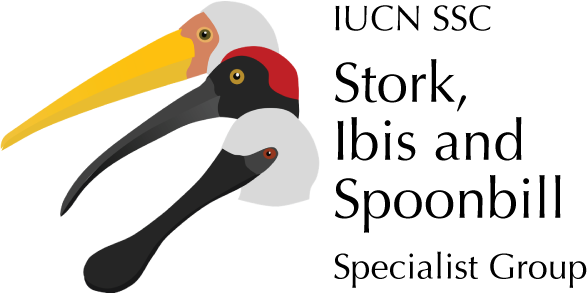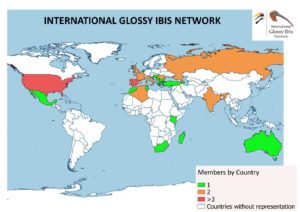
Below is the list of the 41 members, from 25 countries, which currently make up the International Glossy Ibis Network (IGIN). Our scientific publications on, or related to, the Glossy Ibis can be found on the ResearchGate website associated with the network and on the personal webpage of each IGIN member. We actively look for new members so, from time to time, this list will be updated.
IGIN Coordinator:
Simone Santoro, Italy/Spain
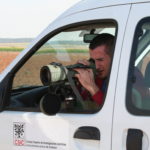 I am an ecologist and, as such, I am interested in the individual and population processes which shape the changes in the distribution and abundance of animal species. So far, most of my research has had to do with aspects of Population and Evolutionary Ecology and host-pathogen dynamics. The Glossy Ibis has been the model species of my PhD and, ever since, I have felt a constant fascination towards this beautiful bird. I am one of the founders, and the current coordinator, of the International Glossy Ibis Network. I hope this research network will allow us to study the metapopulational dynamics of this species, its gene flow and, among others, to investigate the individual variation in fitness-related traits.
I am an ecologist and, as such, I am interested in the individual and population processes which shape the changes in the distribution and abundance of animal species. So far, most of my research has had to do with aspects of Population and Evolutionary Ecology and host-pathogen dynamics. The Glossy Ibis has been the model species of my PhD and, ever since, I have felt a constant fascination towards this beautiful bird. I am one of the founders, and the current coordinator, of the International Glossy Ibis Network. I hope this research network will allow us to study the metapopulational dynamics of this species, its gene flow and, among others, to investigate the individual variation in fitness-related traits.
IGIN Members:
José Alves, Portugal
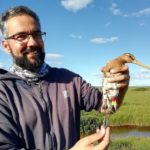 I am fascinated by the natural world. To try and satiate my constant awe for natural systems, I have dedicated my career to try and understand how some of these work – this is a task far from complete but hopefully, I will be able to contribute a bit. I am a conservation ecologist with a specific interest in the mechanisms by which organisms respond to environmental change. I hold a research position at the Department of Biology & CESAM – Centre for Environmental and Marine Studies in the University of Aveiro and I am also a visiting fellow at the University of Iceland, where I spend a considerable part of my annual schedule. My research focuses on patterns of segregation, seasonal interactions, individual trade‐offs, and their consequences for population demography, distribution, and conservation in migratory birds, with considerable biases towards waterbirds.
I am fascinated by the natural world. To try and satiate my constant awe for natural systems, I have dedicated my career to try and understand how some of these work – this is a task far from complete but hopefully, I will be able to contribute a bit. I am a conservation ecologist with a specific interest in the mechanisms by which organisms respond to environmental change. I hold a research position at the Department of Biology & CESAM – Centre for Environmental and Marine Studies in the University of Aveiro and I am also a visiting fellow at the University of Iceland, where I spend a considerable part of my annual schedule. My research focuses on patterns of segregation, seasonal interactions, individual trade‐offs, and their consequences for population demography, distribution, and conservation in migratory birds, with considerable biases towards waterbirds.
José Luis Arroyo, Spain
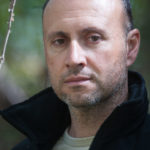
I am a technician working with birds in the Monitoring Team of Natural Processes belonging to Doñana Biological Station-CSIC. My daily work in the Doñana area (Southwest Spain) is monitoring and carry out surveys of passerines, raptors and waterfowls. These activities are complemented by scientific ringing and biological sampling, being the Glossy Ibis one of the species to which special attention has been paid. The monitoring and banding work has resulted, among other things, in some scientific publications on population size, breeding and wintering, and sex determination. My wish is that we can continue to carry out the monitoring of the Glossy Ibis in Doñana as we have been doing for the last 20 years and more. Finally, I think the expertise we have acquired with the species may prove useful to other groups that plan to start a monitoring program of the species, and I am, therefore, open to new collaborations.
Arnaud Béchet, France
 I am a researcher at Tour du Valat, a research institute for the conservation of Mediterranean wetlands located in the Camargue, south of France. I am interested in biodiversity conservation from the scientific, ethical and political points of view. My research focus on population dynamics, behavioural ecology and dispersal ecology in an integrated approach with a particular interest for colonial waterbirds. I am in charge of the long-term study on the Greater flamingo Phoenicopterus roseus at Tour du Valat. I am the co-chair of the IUCN/WI Flamingo specialist group for flamingos of the old world.”
I am a researcher at Tour du Valat, a research institute for the conservation of Mediterranean wetlands located in the Camargue, south of France. I am interested in biodiversity conservation from the scientific, ethical and political points of view. My research focus on population dynamics, behavioural ecology and dispersal ecology in an integrated approach with a particular interest for colonial waterbirds. I am in charge of the long-term study on the Greater flamingo Phoenicopterus roseus at Tour du Valat. I am the co-chair of the IUCN/WI Flamingo specialist group for flamingos of the old world.”
Viktor Belik, Russia
 I am a professor at Southern Federal University, Russia, a member of the Central Council of the Menzbier Ornithological Society, Honorary Member of the Russian Bird Conservation Union, Chairman of the Working Group on Birds of Prey in Northern Eurasia. Among my interests are zoology, ornithology, biogeography, conservation of nature and birds. I have published more than 700 scientific works. I am the author and co-author of 20 monographs and books on animals and nature of different regions of Russia, the Caucasus, the Don and Volga region, Ukraine, Kazakhstan and other regions of the former USSR. I am the editor of the ornithological journal “Strepet”, as well as of some scientific joints.
I am a professor at Southern Federal University, Russia, a member of the Central Council of the Menzbier Ornithological Society, Honorary Member of the Russian Bird Conservation Union, Chairman of the Working Group on Birds of Prey in Northern Eurasia. Among my interests are zoology, ornithology, biogeography, conservation of nature and birds. I have published more than 700 scientific works. I am the author and co-author of 20 monographs and books on animals and nature of different regions of Russia, the Caucasus, the Don and Volga region, Ukraine, Kazakhstan and other regions of the former USSR. I am the editor of the ornithological journal “Strepet”, as well as of some scientific joints.
Andrea Bracko, Croatia
 Since 2010, I serve as Vice-Chair of the Ciconiiformes and Phoenicopteriformes Taxon Advisory Group (TAG) for the European Association of Zoos and Aquaria (EAZA). In that capacity, I work on the creation of ex-situ and in-situ conservation links, and participate in and support relevant research projects. As the EAZA Specified Monitor for Glossy Ibis Plegadis falcinellus I strive to ensure that the captive populations remain healthy and self-sustaining, and an adequate reservoir to support of conservation of the Glossy Ibises in the wild. I hope that the involvement with International Glossy Ibis Network will help the development of management strategies and conservation actions that integrate in-situ and ex-situ management processes. Also, I think that zoo populations may be useful in solving field research questions in a wide range of disciplines and in the development of management techniques, ranging from physiological studies to testing tracking equipment and methods.
Since 2010, I serve as Vice-Chair of the Ciconiiformes and Phoenicopteriformes Taxon Advisory Group (TAG) for the European Association of Zoos and Aquaria (EAZA). In that capacity, I work on the creation of ex-situ and in-situ conservation links, and participate in and support relevant research projects. As the EAZA Specified Monitor for Glossy Ibis Plegadis falcinellus I strive to ensure that the captive populations remain healthy and self-sustaining, and an adequate reservoir to support of conservation of the Glossy Ibises in the wild. I hope that the involvement with International Glossy Ibis Network will help the development of management strategies and conservation actions that integrate in-situ and ex-situ management processes. Also, I think that zoo populations may be useful in solving field research questions in a wide range of disciplines and in the development of management techniques, ranging from physiological studies to testing tracking equipment and methods.
Kate Brandis, Australia

I am employed in the Centre for Ecosystem Science, University of New South Wales. I am a freshwater wetland ecologist, working mainly in the semi-arid and arid zones of Australia. I study the reproductive success of Australia’s three ibis species in relation to wetland flooding and the availability of water. I monitor large nesting colonies and provide advice to water managers regarding the water requirements needed for a successful breeding outcome. I work with both state and federal governments and private landholders. My work contributes to the arguments to get more water for the environment. Hopefully, we can achieve this and provide more wetland habitats for waterbirds, including Glossy Ibis.
Luis Santiago Cano, Spain/Ethiopia
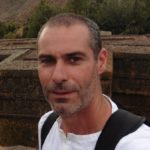 I am member of the Evolution and Conservation Biology Research Group at Complutense University of Madrid as well as co-chair of the IUCN SSC Stork, Ibis and Spoonbill Specialist Group. Since I participated in the First International Workshop on Glossy Ibis in 2017, I have been involved in different activities such as the conformation of the International Glossy Ibis Network, co-edition of the first monograph of the species published at SIS Conservation, and I am co-author of a paper that explores Long-distance Dispersal of the Afro-Eurasian Glossy Ibis From Ring Recoveries. I am interested in researching the mechanisms which drive the population dynamics of the species at large range.
I am member of the Evolution and Conservation Biology Research Group at Complutense University of Madrid as well as co-chair of the IUCN SSC Stork, Ibis and Spoonbill Specialist Group. Since I participated in the First International Workshop on Glossy Ibis in 2017, I have been involved in different activities such as the conformation of the International Glossy Ibis Network, co-edition of the first monograph of the species published at SIS Conservation, and I am co-author of a paper that explores Long-distance Dispersal of the Afro-Eurasian Glossy Ibis From Ring Recoveries. I am interested in researching the mechanisms which drive the population dynamics of the species at large range.
Alejandro Centeno-Cuadros, Spain
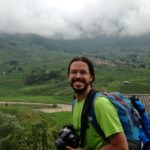 I am a molecular ecologist broadly interested in the application of landscape genetics and phylogeography on conservation biology and population management. During the last years, I mainly focus on the use of molecular techniques for field studies (bringing the lab to the field) and to identify the genetic basis of sex determination in fishes. Together with Simone Santoro, we are leading a project to estimate gene flow among colonies of Glossy ibis throughout its entire distribution range to unravel both the dispersal pathways of the species and the source-sink dynamics within a local scale. To this aim, we have collected samples from all around the world and genotype individuals using molecular markers (microsatellites).
I am a molecular ecologist broadly interested in the application of landscape genetics and phylogeography on conservation biology and population management. During the last years, I mainly focus on the use of molecular techniques for field studies (bringing the lab to the field) and to identify the genetic basis of sex determination in fishes. Together with Simone Santoro, we are leading a project to estimate gene flow among colonies of Glossy ibis throughout its entire distribution range to unravel both the dispersal pathways of the species and the source-sink dynamics within a local scale. To this aim, we have collected samples from all around the world and genotype individuals using molecular markers (microsatellites).
Jocelyn Champagnon, France
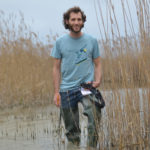 I am a researcher at Tour du Valat, a research institute for the conservation of Mediterranean wetlands. My ecology research projects are mainly in the field of population dynamics. Based on long-term monitoring studies, bird censuses and the marking of individual birds, I am seeking to understand the factors that explain population fluctuations of species. I am interested in Glossy Ibis that are breeding in Camargue, southern France since 2006. Among others, I have studied the effect of research disturbance when ringing ibis in heronry. Current researches on this species focus on the impact of climate on body condition and demographics parameters such as recruitment. I support IGIN since its implementation because I strongly believe in research network. As such, I am Chair of the AEWA Eurasian Spoonbill International Expert Group, and involved in international and local networks for conservation of ducks and pelicans.
I am a researcher at Tour du Valat, a research institute for the conservation of Mediterranean wetlands. My ecology research projects are mainly in the field of population dynamics. Based on long-term monitoring studies, bird censuses and the marking of individual birds, I am seeking to understand the factors that explain population fluctuations of species. I am interested in Glossy Ibis that are breeding in Camargue, southern France since 2006. Among others, I have studied the effect of research disturbance when ringing ibis in heronry. Current researches on this species focus on the impact of climate on body condition and demographics parameters such as recruitment. I support IGIN since its implementation because I strongly believe in research network. As such, I am Chair of the AEWA Eurasian Spoonbill International Expert Group, and involved in international and local networks for conservation of ducks and pelicans.
Mitica Ciorpac, Romania
 I am a young researcher with a recently completed PhD in “avian phylogeny” at the ”Alexandru Ioan Cuza” University of Iași, prior to my PhD program, I graduated a master in Molecular Genetics at the same university. My research experience includes population genetics, animal conservation and genetic tool development projects on different animal species. One of the main taxa addressed in my research is represented by colonial waterbirds from the Danube Delta. I have been involved in avian conservation research with different topics and interdisciplinary approaches varying from species genetic diversity of the colonial waterbirds to eDNA methods development to identify seasonal changes in aquatic fauna or to state assessment of the aquatic ecosystems. My interest in colonial waterbirds species directed me to turn my attention to the Glossy Ibis in Romania. Finally, as a member of the International Glossy Ibis Network, I hope to contribute as much as possible to fill the knowledge gaps regarding this species phylogeny, phylogeography and populations dynamics.
I am a young researcher with a recently completed PhD in “avian phylogeny” at the ”Alexandru Ioan Cuza” University of Iași, prior to my PhD program, I graduated a master in Molecular Genetics at the same university. My research experience includes population genetics, animal conservation and genetic tool development projects on different animal species. One of the main taxa addressed in my research is represented by colonial waterbirds from the Danube Delta. I have been involved in avian conservation research with different topics and interdisciplinary approaches varying from species genetic diversity of the colonial waterbirds to eDNA methods development to identify seasonal changes in aquatic fauna or to state assessment of the aquatic ecosystems. My interest in colonial waterbirds species directed me to turn my attention to the Glossy Ibis in Romania. Finally, as a member of the International Glossy Ibis Network, I hope to contribute as much as possible to fill the knowledge gaps regarding this species phylogeny, phylogeography and populations dynamics.
Antoni Curcó Masip, Spain
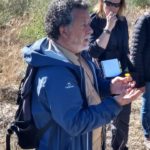
I am a PhD in Biological Sciences from the University of Barcelona. My doctoral thesis was about floristic diversity, phytocoenology, cartography and ecology of wetland communities. Currently, I am the coordinator of the Conservation and Research Programme of the Ebre Delta Natural Park (Catalonia, Spain). My multidisciplinary profile covers bird monitoring, conservation biology, and nature conservation planning and management. The long-term monitoring work I do, focuses on wintering (International Waterbird Census) and breeding waterbirds, particularly on threatened species (gulls and sterns, herons, flamingo, waders). The Glossy Ibis, as a recent coloniser (1998), is in the spotlight of my work. From 2007 I am a member of the IUCN SSC and Wetlands International Flamingo Specialist Group.
Alexandru Dorosencu, Romania
 Alexandru Dorosencu is a senior researcher of Danube Delta National Institute for Research and Development (DDNI) based in Romania. Since the autumn of 2003 when he got the research position at the DDNI, he has been a member of the expert team and project manager of various national and international biodiversity programmes, notably the studies and implementation of the Birds and Habitats Directives and the European network of protected areas Natura 2000 in Romania. He has worked for evaluation of the impact of wind farms and electric lines on birds in South-Eastern Romania. He holds a PhD in Ornithology since 2011. Current focal projects include long-term monitoring of and research on nesting and foraging colonial waterbirds in Danube Delta Biosphere Reserve. He is involved in an extensive sampling program from endangered wildlife species from this area, using non-invasive methods, in order to determine their genetic diversity. His research interests lie at the interface between behavioural ecology – especially how animals can respond to environmental change and variation – and conservation biology. He is particularly interested in the effect of anthropogenic development and hydrological processes on species, spatial behaviour and habitat use.
Alexandru Dorosencu is a senior researcher of Danube Delta National Institute for Research and Development (DDNI) based in Romania. Since the autumn of 2003 when he got the research position at the DDNI, he has been a member of the expert team and project manager of various national and international biodiversity programmes, notably the studies and implementation of the Birds and Habitats Directives and the European network of protected areas Natura 2000 in Romania. He has worked for evaluation of the impact of wind farms and electric lines on birds in South-Eastern Romania. He holds a PhD in Ornithology since 2011. Current focal projects include long-term monitoring of and research on nesting and foraging colonial waterbirds in Danube Delta Biosphere Reserve. He is involved in an extensive sampling program from endangered wildlife species from this area, using non-invasive methods, in order to determine their genetic diversity. His research interests lie at the interface between behavioural ecology – especially how animals can respond to environmental change and variation – and conservation biology. He is particularly interested in the effect of anthropogenic development and hydrological processes on species, spatial behaviour and habitat use.
Susan Baumgartner Elbin, United States of America
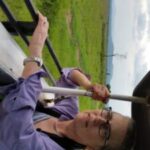 I am an ornithologist/behavioral ecologist. I met “Geronticologist” Dave Manry in 1981 when I was a student at the Percy FitzPatrick Institute of African Ornithology. He introduced me to the world of ibis and helped sway my passion from guineafowl to ibis! My PhD research was on Waldrapp and Scarlet Ibis in captivity and was the springboard to my work with Glossy Ibis in the New York Harbor, where I have been monitoring their breeding populations. Since 2006, I have been banding Glossy Ibis chicks with plastic, field readable leg bands. Most of the banding activity occurred between 2008-2010. As of 31 December 2019, I am retired from NYC Audubon as Director of Conservation and Science but I assume the title of Emeritus Scientist.
I am an ornithologist/behavioral ecologist. I met “Geronticologist” Dave Manry in 1981 when I was a student at the Percy FitzPatrick Institute of African Ornithology. He introduced me to the world of ibis and helped sway my passion from guineafowl to ibis! My PhD research was on Waldrapp and Scarlet Ibis in captivity and was the springboard to my work with Glossy Ibis in the New York Harbor, where I have been monitoring their breeding populations. Since 2006, I have been banding Glossy Ibis chicks with plastic, field readable leg bands. Most of the banding activity occurred between 2008-2010. As of 31 December 2019, I am retired from NYC Audubon as Director of Conservation and Science but I assume the title of Emeritus Scientist.
Vitor Manuel Ferreira Encarnação, Portugal
 I am a geographer at the University of Lisbon. Currently, I am the coordinator of CEMPA, a centre for the study of bird migration and protection, of the Institute for Nature Conservation and Forests, the national authority for nature conservation, where I work since 1976. Also, I coordinate since 2000 the program of waterfowl monitoring. My field-work has included monitoring programs of waterfowl in the S. Jacinto Natural Reserve during 11 years, of waders during five years in the Natural Park of Ria Formosa in South Portugal. I coordinated the national white stork censuses in 2004 and 2014. I have been the responsible for the colonial birds’ counts for the II Breeding Bird Atlas in Portugal and coordinated the counts of colonial birds and large birds of prey for the III Breeding Bird Atlas. Finally, I have been a co-author of the Portuguese action plan for a purple heron. My current focal projects include long-term monitoring and research on nesting of herons, egrets, black stork, ibises and cormorants in the country.
I am a geographer at the University of Lisbon. Currently, I am the coordinator of CEMPA, a centre for the study of bird migration and protection, of the Institute for Nature Conservation and Forests, the national authority for nature conservation, where I work since 1976. Also, I coordinate since 2000 the program of waterfowl monitoring. My field-work has included monitoring programs of waterfowl in the S. Jacinto Natural Reserve during 11 years, of waders during five years in the Natural Park of Ria Formosa in South Portugal. I coordinated the national white stork censuses in 2004 and 2014. I have been the responsible for the colonial birds’ counts for the II Breeding Bird Atlas in Portugal and coordinated the counts of colonial birds and large birds of prey for the III Breeding Bird Atlas. Finally, I have been a co-author of the Portuguese action plan for a purple heron. My current focal projects include long-term monitoring and research on nesting of herons, egrets, black stork, ibises and cormorants in the country.
Jordi Figuerola, Spain
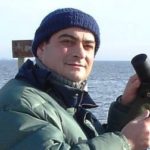 I have studied the establishment and growth of the breeding population of Glossy Ibis in Doñana and their expansion through Spain and southwest Europe. I am interested in understanding the impact of the environment on the population dynamics, including dispersal and how the increase in the population is affecting demographics and life-history parameters and the movements between colonies. I have published on the importance of rice-fields for the Glossy Ibis in south Spain, provided tools for sex determination in the field, analysed the impact of climate, sex and other factors on individual dispersal and studied the importance of immigration and emigration on the dynamics of the Glossy Ibis in Doñana.
I have studied the establishment and growth of the breeding population of Glossy Ibis in Doñana and their expansion through Spain and southwest Europe. I am interested in understanding the impact of the environment on the population dynamics, including dispersal and how the increase in the population is affecting demographics and life-history parameters and the movements between colonies. I have published on the importance of rice-fields for the Glossy Ibis in south Spain, provided tools for sex determination in the field, analysed the impact of climate, sex and other factors on individual dispersal and studied the importance of immigration and emigration on the dynamics of the Glossy Ibis in Doñana.
Marcello Grussu, Italy
 I was born and live in Sardinia (Italy). Since 1997, I am a researcher of the Sardinian Ornithological Group, and I am its chairman ever since. Also, I worked with museums, universities, natural and scientific associations, public and private institutions on studies on spatial and temporal dynamics of the birds of my island and Central Mediterranean. My interest in waterfowl and colonial species has led me to discover the first breeding pairs of Glossy Ibis in Sardinia. Since then, I follow with particular attention to the presence of this ibis in Sardinia and the dynamics of its metapopulation in the Mediterranean. Finally, I am an enthusiastic member of the International Glossy Ibis Network.
I was born and live in Sardinia (Italy). Since 1997, I am a researcher of the Sardinian Ornithological Group, and I am its chairman ever since. Also, I worked with museums, universities, natural and scientific associations, public and private institutions on studies on spatial and temporal dynamics of the birds of my island and Central Mediterranean. My interest in waterfowl and colonial species has led me to discover the first breeding pairs of Glossy Ibis in Sardinia. Since then, I follow with particular attention to the presence of this ibis in Sardinia and the dynamics of its metapopulation in the Mediterranean. Finally, I am an enthusiastic member of the International Glossy Ibis Network.
Savas Kazantzidis, Greece

I am a biologist working at the Wildlife laboratory of the Forest Research Institute in Greece (www.fri.gr). I have a PhD on the breeding ecology of Little Egret. My research interests are mainly in species breeding colonially in heronries, as well as, on wintering waterfowl ecology and management. The Glossy Ibis has been an object of my study within the research I do in mixed heron colonies. To find out the migrating routes and wintering grounds of Glossy Ibis nesting in Greece, I initiated, in 2018, a ringing project. I hope that the IGIN, among others, will stimulate interest in research of this species in Greece and at a broader scale.
Sergey Pavlovich Kharitonov, Russia
 I am an ornithologist, D.Sc., mainly interested in biology and behaviour of colonial and large birds in the tundra communities (geese, gulls, birds of prey, owls). In particular, pay much attention to the behavioural relations between birds and the spatial population structures. As a staff member of the Bird Ringing Centre of Russia, I study migration and population parameters (survival, mortality, population movements) of many birds groups, including wildfowl (swans, geese and ducks), and separate species as Common and Black-faced Spoonbills and Glossy Ibis. Also, I work on avian influence studies. At this time, I have 212 scientific publications, many of them available in my ResearchGate profile.
I am an ornithologist, D.Sc., mainly interested in biology and behaviour of colonial and large birds in the tundra communities (geese, gulls, birds of prey, owls). In particular, pay much attention to the behavioural relations between birds and the spatial population structures. As a staff member of the Bird Ringing Centre of Russia, I study migration and population parameters (survival, mortality, population movements) of many birds groups, including wildfowl (swans, geese and ducks), and separate species as Common and Black-faced Spoonbills and Glossy Ibis. Also, I work on avian influence studies. At this time, I have 212 scientific publications, many of them available in my ResearchGate profile.
Manuel Mañez, Spain
 I am a biologist at the Estación Biológica de Doñana, Spanish National Research Council (CSIC), since 2001. Since then, I am working in the Natural Processes Monitoring Team (NPMT), which is responsible for the Doñana Monitoring Program. Our team also supports research projects. Part of my job is to coordinate the Bird Monitoring Group of the ICTS-Biological Reserve NPMT, which monitors the birds’ wintering, breeding and migration. Currently, a particularly relevant bird species in Doñana is the Glossy Ibis, which, in about twenty years (1996 – 2017), has gone from seven breeding pairs to more than 10,000. Doñana currently hosts the numerically most extensive breeding and wintering population in Western Europe. The total number of chicks ringed until 2017 exceeds 17,500, with more than 29,000 resightings, providing essential information on the Glossy Ibis phenology and population dynamics.
I am a biologist at the Estación Biológica de Doñana, Spanish National Research Council (CSIC), since 2001. Since then, I am working in the Natural Processes Monitoring Team (NPMT), which is responsible for the Doñana Monitoring Program. Our team also supports research projects. Part of my job is to coordinate the Bird Monitoring Group of the ICTS-Biological Reserve NPMT, which monitors the birds’ wintering, breeding and migration. Currently, a particularly relevant bird species in Doñana is the Glossy Ibis, which, in about twenty years (1996 – 2017), has gone from seven breeding pairs to more than 10,000. Doñana currently hosts the numerically most extensive breeding and wintering population in Western Europe. The total number of chicks ringed until 2017 exceeds 17,500, with more than 29,000 resightings, providing essential information on the Glossy Ibis phenology and population dynamics.
Antonio Martínez Blanco, Spain
 I am a biologist based at the Estación Biológica de Doñana, Spanish National Research Council (CSIC), Spain, since 2007. I am currently working as a member of the Natural Process Monitoring Team which is responsible, since the 1980s, for conducting the Monitoring Program in the Doñana Natural Area. This team also supports research projects both through advice and orientation and direct collaboration in field-work. My work focuses on the monitoring of the wintering, breeding or migratory steps of birds, for which monthly censuses are carried out. Currently, one of the most important species is the Glossy Ibis, since seven breeding pairs established in 1996. Progressively, their number increased quickly to several thousand pairs and Doñana now holds the most important breeding and probably wintering population in western Europe. The total number of birds ringed until 2017 is 17,565, that provide a large number of resightings, very useful to obtain valuable information about phenology and behaviour of this species.
I am a biologist based at the Estación Biológica de Doñana, Spanish National Research Council (CSIC), Spain, since 2007. I am currently working as a member of the Natural Process Monitoring Team which is responsible, since the 1980s, for conducting the Monitoring Program in the Doñana Natural Area. This team also supports research projects both through advice and orientation and direct collaboration in field-work. My work focuses on the monitoring of the wintering, breeding or migratory steps of birds, for which monthly censuses are carried out. Currently, one of the most important species is the Glossy Ibis, since seven breeding pairs established in 1996. Progressively, their number increased quickly to several thousand pairs and Doñana now holds the most important breeding and probably wintering population in western Europe. The total number of birds ringed until 2017 is 17,565, that provide a large number of resightings, very useful to obtain valuable information about phenology and behaviour of this species.
Carlos Moreno, Spain
 I am an ornithologist and a bird ringer for many years. I work at the Estación Biológica de Doñana (EBD, CSIC – Spain) in the monitoring of birds, including the Glossy Ibis. I currently work in the Banding Office, playing a pivotal role in coordinating the markings, with darvic rings, of this (and many other) species in the Palearctic. The Glossy Ibis is an essential species among the Doñana bird populations. I think it has been exceptionally fortunate that the EBD Monitoring Team performed a follow-up of the species from the very first moment when it established in 1996 with only seven breeding pairs. The resulting ringing data provide critical information to study the dynamics of the species in the Euro-Mediterranean region.
I am an ornithologist and a bird ringer for many years. I work at the Estación Biológica de Doñana (EBD, CSIC – Spain) in the monitoring of birds, including the Glossy Ibis. I currently work in the Banding Office, playing a pivotal role in coordinating the markings, with darvic rings, of this (and many other) species in the Palearctic. The Glossy Ibis is an essential species among the Doñana bird populations. I think it has been exceptionally fortunate that the EBD Monitoring Team performed a follow-up of the species from the very first moment when it established in 1996 with only seven breeding pairs. The resulting ringing data provide critical information to study the dynamics of the species in the Euro-Mediterranean region.
Riad Nedjah, Algeria
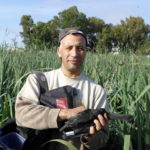 I am a researcher member of the Wetlands Conservation Laboratory at 8 Mai 1945 University, Guelma, Algeria. The objective of our work is to promote the biodiversity of Algerian wetlands and to conserve them. The population of Glossy Ibis has been monitored In Numidia since 2002 together with other colonial waterbird species: Herons and Egrets. We have focused on aspects like breeding, behaviour and spatiotemporal dynamics. We have banded, in collaboration with the Estación Biológica de Doñana (CSIC, Spain), more than 1,000 Glossy Ibis chicks in the region of Numidia, North East of Algeria (the first and only program with these characteristics in North Africa). This intensive monitoring program has allowed us to investigate the link of this population with other breeding colonies and its role within the metapopulation dynamics.
I am a researcher member of the Wetlands Conservation Laboratory at 8 Mai 1945 University, Guelma, Algeria. The objective of our work is to promote the biodiversity of Algerian wetlands and to conserve them. The population of Glossy Ibis has been monitored In Numidia since 2002 together with other colonial waterbird species: Herons and Egrets. We have focused on aspects like breeding, behaviour and spatiotemporal dynamics. We have banded, in collaboration with the Estación Biológica de Doñana (CSIC, Spain), more than 1,000 Glossy Ibis chicks in the region of Numidia, North East of Algeria (the first and only program with these characteristics in North Africa). This intensive monitoring program has allowed us to investigate the link of this population with other breeding colonies and its role within the metapopulation dynamics.
Aymen Nefla, Tunisia
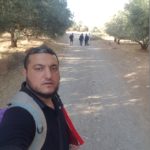 I am an ecologist focusing on the ecology of animal populations, especially birds. Solutions to real-world wild fauna problems typically require an understanding of basic ecological patterns and vital processes like distribution, feeding and reproduction. Thus, my research aims to unravel the environmental requirements needed by threatened animals, mostly birds, by investigating the effects of factors such as habitat type, phenology, predation and food availability on their distribution, intake rate, foraging behaviour, and reproductive performance. The Glossy Ibis has been one of the most important model species during my PhD. I have reported the first breeding evidence of this species in Tunisia. Currently, as part of the IGIN’s work, I continue to perform count surveys of the wintering populations and monitoring any new breeding attempt. I hope to manage to start a ringing program and collect blood samples to investigate the genetic origins and dispersal dynamics of the Tunisian populations.
I am an ecologist focusing on the ecology of animal populations, especially birds. Solutions to real-world wild fauna problems typically require an understanding of basic ecological patterns and vital processes like distribution, feeding and reproduction. Thus, my research aims to unravel the environmental requirements needed by threatened animals, mostly birds, by investigating the effects of factors such as habitat type, phenology, predation and food availability on their distribution, intake rate, foraging behaviour, and reproductive performance. The Glossy Ibis has been one of the most important model species during my PhD. I have reported the first breeding evidence of this species in Tunisia. Currently, as part of the IGIN’s work, I continue to perform count surveys of the wintering populations and monitoring any new breeding attempt. I hope to manage to start a ringing program and collect blood samples to investigate the genetic origins and dispersal dynamics of the Tunisian populations.
Ortaç Onmus, Turkey
Summary not yet available
H. Dieter Oschadleus, South Africa
I am an ornithologist, and co-ordinated SAFRING, the bird ringing scheme for southern Africa, 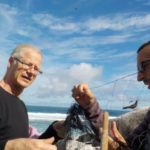 for 20 years. I am now self employed, still a main focus on ringing any African birds (AFRING), and a research focus on the weaverbirds (family Ploceidae). Weavers often occur in wetlands, and so I am also particularly interested in other waterbird species, including all the ibis species. In terms of ringing research, I am interested in longevities and survival, movements of birds, as well as variation in biometrics. As part of my work, I have participated in scientific works focused on the Glossy Ibis. I am linked with both the University of Cape Town and the University of KwaZulu-Natal as Honorary Research Fellows.
for 20 years. I am now self employed, still a main focus on ringing any African birds (AFRING), and a research focus on the weaverbirds (family Ploceidae). Weavers often occur in wetlands, and so I am also particularly interested in other waterbird species, including all the ibis species. In terms of ringing research, I am interested in longevities and survival, movements of birds, as well as variation in biometrics. As part of my work, I have participated in scientific works focused on the Glossy Ibis. I am linked with both the University of Cape Town and the University of KwaZulu-Natal as Honorary Research Fellows.
Csaba Pigniczki, Hungary
 My main interest is the Eurasian Spoonbill and, as closely related species, I actively search and work in Hungary with herons and the Glossy Ibis too. In the case of Glossy Ibis, I started to follow its Hungarian breeding population a few years ago. I plan to begin banding activities with this species using colour-rings in the heron colonies of the Great Hungarian Plains soon.
My main interest is the Eurasian Spoonbill and, as closely related species, I actively search and work in Hungary with herons and the Glossy Ibis too. In the case of Glossy Ibis, I started to follow its Hungarian breeding population a few years ago. I plan to begin banding activities with this species using colour-rings in the heron colonies of the Great Hungarian Plains soon.
Slobodan Puzovic, Serbia
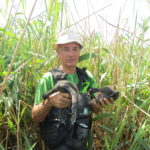 I am an ornithologist and naturalist with various fields of interest, primarily related to birds ecology, population and distribution patterns and dynamics, as well as protection of birds and management of their habitats. In the previous two decades, I have coordinated the Serbia BirdLife International programme IBA (Important Bird Areas) and, among other species, I focused on the Glossy Ibis as to designate particular IBA areas. In 2018, I was the editor of the ’Red Book of Fauna of Serbia – Birds’, and the author of the chapter on the Glossy Ibis. I have coordinated the Serbia BirdLife International programme BiE2 and BiE3 (Birds in Europe) evaluating and assessing the Glossy Ibis distribution and population size. I have been involved, in quality of referee, in the preparation of the first comprehensive Atlas of Migratory Birds and Bats of Serbia in 2018. This volume contains all the data on Glossy Ibis marking, ringing, finding and recovering. In the Obedska bara protected area, together with several partners and volunteers, I launched the International long-term programme ’Return of Ibis’ in 1992. The purpose of this initiative was to ensure suitable habitats and other favourable conditions for the return of the Glossy Ibis as a regular breeding species. We succeeded in our purpose and, in 2016, this species bred in the area. In the future, I want to give my contribution to the work of the IGIN, promoting the conservation of this species, and investigating the Glossy Ibis population dynamics and distribution, migration and ecology.
I am an ornithologist and naturalist with various fields of interest, primarily related to birds ecology, population and distribution patterns and dynamics, as well as protection of birds and management of their habitats. In the previous two decades, I have coordinated the Serbia BirdLife International programme IBA (Important Bird Areas) and, among other species, I focused on the Glossy Ibis as to designate particular IBA areas. In 2018, I was the editor of the ’Red Book of Fauna of Serbia – Birds’, and the author of the chapter on the Glossy Ibis. I have coordinated the Serbia BirdLife International programme BiE2 and BiE3 (Birds in Europe) evaluating and assessing the Glossy Ibis distribution and population size. I have been involved, in quality of referee, in the preparation of the first comprehensive Atlas of Migratory Birds and Bats of Serbia in 2018. This volume contains all the data on Glossy Ibis marking, ringing, finding and recovering. In the Obedska bara protected area, together with several partners and volunteers, I launched the International long-term programme ’Return of Ibis’ in 1992. The purpose of this initiative was to ensure suitable habitats and other favourable conditions for the return of the Glossy Ibis as a regular breeding species. We succeeded in our purpose and, in 2016, this species bred in the area. In the future, I want to give my contribution to the work of the IGIN, promoting the conservation of this species, and investigating the Glossy Ibis population dynamics and distribution, migration and ecology.
Rivo Rabarisoa, Madagascar
 I am a Malagasy biologist, a researcher at the University of Antananarivo, national coordinator of the Africa-Eurasian Waterbird Census network in Madagascar, and a member of IGIN. I work on wetland conservation and management. My background is mainly in waterbirds and their habitat conservation, with a particular focus on the anthropogenic impact of human settlements and activities on their distribution. I am interested in the use of data information to support conservation policies like the development and implementation of sites restoration and management, species action plans, and to support Malagasy government on the implementation of the international convention agreed by the country (Ramsar Convention and the African-Eurasian migratory Waterbird Agreement). I am also interested in the Glossy Ibis Plegadis falcinellus falcinellus, a little-studied that might reveal as a Malagasy subspecies. Is it really a subpopulation? A considerable number of Glossy Ibises inhabit this country which should motivate us to improve our knowledge of the species occurrence in Madagascar (bioecology, the importance of the species for locals, etc.).
I am a Malagasy biologist, a researcher at the University of Antananarivo, national coordinator of the Africa-Eurasian Waterbird Census network in Madagascar, and a member of IGIN. I work on wetland conservation and management. My background is mainly in waterbirds and their habitat conservation, with a particular focus on the anthropogenic impact of human settlements and activities on their distribution. I am interested in the use of data information to support conservation policies like the development and implementation of sites restoration and management, species action plans, and to support Malagasy government on the implementation of the international convention agreed by the country (Ramsar Convention and the African-Eurasian migratory Waterbird Agreement). I am also interested in the Glossy Ibis Plegadis falcinellus falcinellus, a little-studied that might reveal as a Malagasy subspecies. Is it really a subpopulation? A considerable number of Glossy Ibises inhabit this country which should motivate us to improve our knowledge of the species occurrence in Madagascar (bioecology, the importance of the species for locals, etc.).
Ruben Rodríguez Olivares, Spain
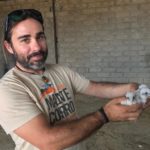 I belong to the Natural Processes Monitoring Team of the Estación Biológica de Doñana (CSIC – Spain). My job as ornithologist and bird ringer covers the monitoring and marking, throughout the entire year, of all the bird species in the Doñana protected area. I have been monitoring the breeding and wintering population of the Glossy Ibis for many years. The monitoring work consists mainly of land (car, horse or walking) and air counts. I had the opportunity to participate in the Glossy Ibis banding almost from the first moment when they settled in the Guadalquivir marshes, and I am especially proud of it because my work has contributed to creating an extensive database which is proving helpful to improve our knowledge of this beautiful bird species.
I belong to the Natural Processes Monitoring Team of the Estación Biológica de Doñana (CSIC – Spain). My job as ornithologist and bird ringer covers the monitoring and marking, throughout the entire year, of all the bird species in the Doñana protected area. I have been monitoring the breeding and wintering population of the Glossy Ibis for many years. The monitoring work consists mainly of land (car, horse or walking) and air counts. I had the opportunity to participate in the Glossy Ibis banding almost from the first moment when they settled in the Guadalquivir marshes, and I am especially proud of it because my work has contributed to creating an extensive database which is proving helpful to improve our knowledge of this beautiful bird species.
Boudjéma Samraoui, Algeria
 I am a biologist at the University of Annaba and the Laboratoire de Conservation des Zones Humides, University 8 mai 1945 Guelma, Algeria. I have been interested in the ecology of herons and ibis since the early 2000s when, with the help of students later turned colleagues, we investigated the breeding ecology of the Glossy Ibis. In 2008 and in collaboration with Dr Jordi Figuerola (Estación Biológica de Doñana, CSIC – Spain), we started a ringing program of the Glossy Ibis that allowed us to study its dispersal and metapopulational dynamics. Currently, we are investigating the foraging strategies, diet, and various other aspects of the ecology of the species in northeastern Algeria and comparing it to other regions of the species’ range.
I am a biologist at the University of Annaba and the Laboratoire de Conservation des Zones Humides, University 8 mai 1945 Guelma, Algeria. I have been interested in the ecology of herons and ibis since the early 2000s when, with the help of students later turned colleagues, we investigated the breeding ecology of the Glossy Ibis. In 2008 and in collaboration with Dr Jordi Figuerola (Estación Biológica de Doñana, CSIC – Spain), we started a ringing program of the Glossy Ibis that allowed us to study its dispersal and metapopulational dynamics. Currently, we are investigating the foraging strategies, diet, and various other aspects of the ecology of the species in northeastern Algeria and comparing it to other regions of the species’ range.
Oscar Sánchez-Macouzet, Mexico/France
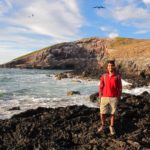 I am a behavioural ecologist, currently post-doc at the Tour du Valat (France), with broad research interests in birds, life-history strategies and the adaptive significance of individual-level variation. My work usually combines the analysis of long-term data on wild bird populations with a variety of empirical approaches (e.g. bio-logging) that help uncover the behavioural mechanisms underlying selection. At present, I am particularly interested in understanding how individuals respond to complex and often changing environmental conditions, using the Glossy Ibis as a model species. Specifically, I am investigating the short-term effects of interacting climatic parameters on chick body condition, and how this relates to later life-histories and, ultimately, the Glossy’s population dynamics.
I am a behavioural ecologist, currently post-doc at the Tour du Valat (France), with broad research interests in birds, life-history strategies and the adaptive significance of individual-level variation. My work usually combines the analysis of long-term data on wild bird populations with a variety of empirical approaches (e.g. bio-logging) that help uncover the behavioural mechanisms underlying selection. At present, I am particularly interested in understanding how individuals respond to complex and often changing environmental conditions, using the Glossy Ibis as a model species. Specifically, I am investigating the short-term effects of interacting climatic parameters on chick body condition, and how this relates to later life-histories and, ultimately, the Glossy’s population dynamics.
Elchin Hafiz Sultanov, Azerbaijan
 I am an ornithologist with 40 years of experience in field research with birds. My research interests are in behaviour, especially acoustic behavior, of birds, their habitat distribution and abundance, dynamics, relations between bird populations and other parts of the ecosystem like plants, soil etc. During our studies of waterbird breeding colonies in Azerbaijan, we have revealed that the Glossy Ibis is one of the most common and abundant breeding waterbirds in Azerbaijan. Therefore, the Glossy Ibis well deserves to be a flagship species of Azerbaijan waterbirds. I worked more than 25 years in the Institute of Zoology of Azerbaijan National Academy of Sciences and, during 18 years, as the researcher head of the Ornithological Laboratory. Then, I started to work for the Azerbaijan Ornithological Society (AOS) created by a group of enthusiastic Azerbaijan ornithologists. Since 2005, I am the director of AOS and, in this capacity, I have implemented about 100 research projects for the conservation of birds in Azerbaijan. Currently, I am also an Associate Professor at Baku Engineering University where I teach vertebrates’ zoology, general ecology and animal behaviour.
I am an ornithologist with 40 years of experience in field research with birds. My research interests are in behaviour, especially acoustic behavior, of birds, their habitat distribution and abundance, dynamics, relations between bird populations and other parts of the ecosystem like plants, soil etc. During our studies of waterbird breeding colonies in Azerbaijan, we have revealed that the Glossy Ibis is one of the most common and abundant breeding waterbirds in Azerbaijan. Therefore, the Glossy Ibis well deserves to be a flagship species of Azerbaijan waterbirds. I worked more than 25 years in the Institute of Zoology of Azerbaijan National Academy of Sciences and, during 18 years, as the researcher head of the Ornithological Laboratory. Then, I started to work for the Azerbaijan Ornithological Society (AOS) created by a group of enthusiastic Azerbaijan ornithologists. Since 2005, I am the director of AOS and, in this capacity, I have implemented about 100 research projects for the conservation of birds in Azerbaijan. Currently, I am also an Associate Professor at Baku Engineering University where I teach vertebrates’ zoology, general ecology and animal behaviour.
Gopi Sundar, India
Summary not yet available
Nellie Tsipoura, USA
Summary not yet available
Les Underhill, South Africa
Summary not yet available
Pablo Vera, Spain
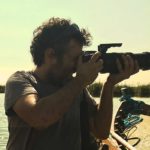 I obtained my PhD in 2017 on the conservation biology of the Eastern Iberian Reed Bunting, a strongly endangered wetland passerine endemic to the Western Mediterranean wetlands, investigating its habitat selection, genetic structure and population trend. Nowadays, I am a conservation biologist working in SEO/BirdLife (the Spanish Ornithological Society, representative of BirdLife International in Spain) in the conservation of coastal wetlands and biodiversity monitoring, mainly in l’Albufera de València (East Spain). Our main operational objectives are to improve the conservation status of several endangered waterfowl and species linked to wetlands through improving management measures according to research information. One of our most relevant monitoring programs is for the Glossy Ibis wintering and breeding populations. For all of them, we are developing studies on their population dynamics, and their interactions with land use such as rice farming.
I obtained my PhD in 2017 on the conservation biology of the Eastern Iberian Reed Bunting, a strongly endangered wetland passerine endemic to the Western Mediterranean wetlands, investigating its habitat selection, genetic structure and population trend. Nowadays, I am a conservation biologist working in SEO/BirdLife (the Spanish Ornithological Society, representative of BirdLife International in Spain) in the conservation of coastal wetlands and biodiversity monitoring, mainly in l’Albufera de València (East Spain). Our main operational objectives are to improve the conservation status of several endangered waterfowl and species linked to wetlands through improving management measures according to research information. One of our most relevant monitoring programs is for the Glossy Ibis wintering and breeding populations. For all of them, we are developing studies on their population dynamics, and their interactions with land use such as rice farming.
Stefano Volponi, Italy
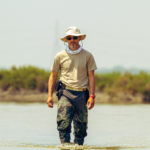 I am genuinely interested in the ecology and conservation of wetlands and waterfowl. My interests have much to do with the place I live in since my childhood: Ravenna (NE Italy). This ancient town is strategically located in the southern Po Delta, surrounded by freshwater wetlands and coastal lagoons and just a few km far from the nature reserve of Punte Alberete. Here, since the 1970s, Glossy Ibises have regularly bred in a large mixed heronry where all the European Pelecaniformes and two cormorants species gather. My long-term work with colonial waterbirds and the Glossy Ibis started at Punte Alberete in the early 1990s, mainly including nest counts and marking nestlings as part of national research programs. More recently, the foundation of the IUCN-SIS Group and the concurrent expansion of the Glossy Ibis local population have attracted new interest on this species leading my team to (i) monitor colony occupancy and breeding success; (ii) collect biological samples for genetic studies; (iii) colour-ring nestlings; (iv) look for marked individuals and, last but not least, (v) observe interactions with the alien Sacred Ibises which widely share the same feeding and breeding areas of the autochthonous ibis.
I am genuinely interested in the ecology and conservation of wetlands and waterfowl. My interests have much to do with the place I live in since my childhood: Ravenna (NE Italy). This ancient town is strategically located in the southern Po Delta, surrounded by freshwater wetlands and coastal lagoons and just a few km far from the nature reserve of Punte Alberete. Here, since the 1970s, Glossy Ibises have regularly bred in a large mixed heronry where all the European Pelecaniformes and two cormorants species gather. My long-term work with colonial waterbirds and the Glossy Ibis started at Punte Alberete in the early 1990s, mainly including nest counts and marking nestlings as part of national research programs. More recently, the foundation of the IUCN-SIS Group and the concurrent expansion of the Glossy Ibis local population have attracted new interest on this species leading my team to (i) monitor colony occupancy and breeding success; (ii) collect biological samples for genetic studies; (iii) colour-ring nestlings; (iv) look for marked individuals and, last but not least, (v) observe interactions with the alien Sacred Ibises which widely share the same feeding and breeding areas of the autochthonous ibis.
Graham White, United Kingdom
 I am Head of Ecology, RSPB, UK, with an interest in ensuring our nature reserves support appropriate conditions for colonising species, including the Glossy Ibis. The RSPB continues to monitor the occurrence of Glossy Ibis and other potential colonising species within the UK and, in particular, on our 220 nature reserves. Although records are increasing, there is no confirmed breeding in the UK as yet. Through our ongoing reserve management plan and audit process, we review habitat quality for colonising species to ensure nesting and feeding conditions are appropriate in key locations.
I am Head of Ecology, RSPB, UK, with an interest in ensuring our nature reserves support appropriate conditions for colonising species, including the Glossy Ibis. The RSPB continues to monitor the occurrence of Glossy Ibis and other potential colonising species within the UK and, in particular, on our 220 nature reserves. Although records are increasing, there is no confirmed breeding in the UK as yet. Through our ongoing reserve management plan and audit process, we review habitat quality for colonising species to ensure nesting and feeding conditions are appropriate in key locations.
Leo Zwarts, The Netherlands
 I work at Altenburg & Wymenga, a Dutch ecological research and consulting firm. I started my life as researcher studying the relation between wading birds and their estuarine prey, but two coincidental events caused a shift from marine, intertidal flat to fresh-water floodplains in Africa. A colleague asked in 1982 whether I wanted to go with him for three months to West Africa in search of spoonbills. I could not let that chance pass and when, ten years later, I had the opportunity to work on waterfowl in the Inner Niger Delta in Mali, I got it with both hands. What is more beautiful than an emerging floodplain with tens of thousands of Black-tailed godwits and Ruffs and … many thousands of Glossy Ibises (all feeding on the same fresh-water cockles). Unfortunately, of the 30,000 Glossy Ibises that spent the winter in the Inner Niger Delta 30-40 years ago, only a fraction is left, which has only enhanced my love for the Glossy Ibis.
I work at Altenburg & Wymenga, a Dutch ecological research and consulting firm. I started my life as researcher studying the relation between wading birds and their estuarine prey, but two coincidental events caused a shift from marine, intertidal flat to fresh-water floodplains in Africa. A colleague asked in 1982 whether I wanted to go with him for three months to West Africa in search of spoonbills. I could not let that chance pass and when, ten years later, I had the opportunity to work on waterfowl in the Inner Niger Delta in Mali, I got it with both hands. What is more beautiful than an emerging floodplain with tens of thousands of Black-tailed godwits and Ruffs and … many thousands of Glossy Ibises (all feeding on the same fresh-water cockles). Unfortunately, of the 30,000 Glossy Ibises that spent the winter in the Inner Niger Delta 30-40 years ago, only a fraction is left, which has only enhanced my love for the Glossy Ibis.
